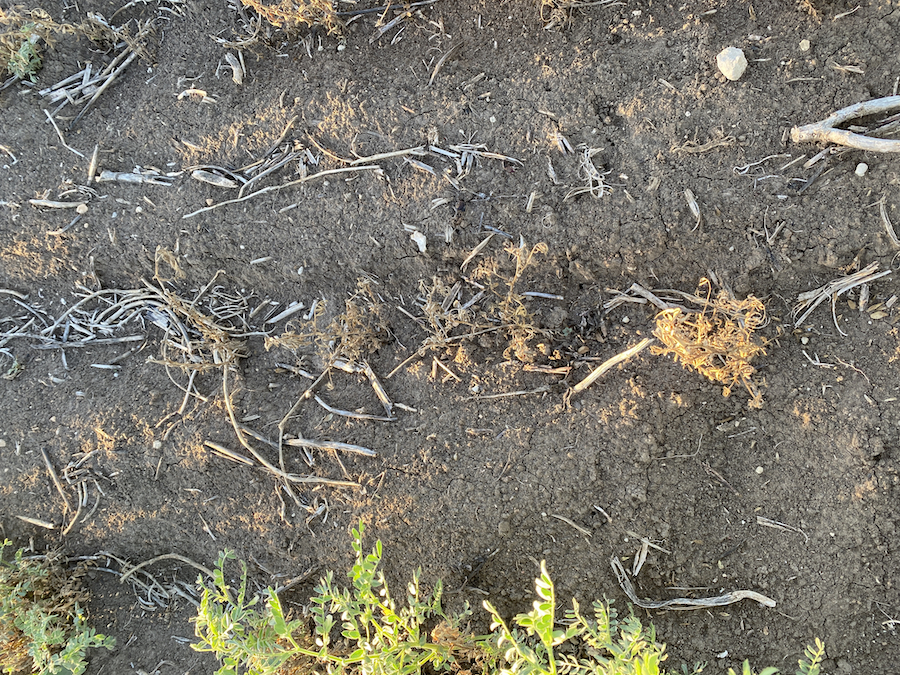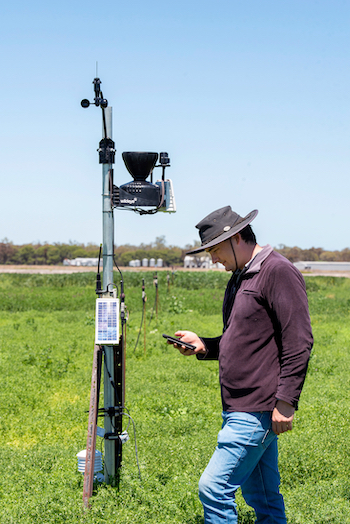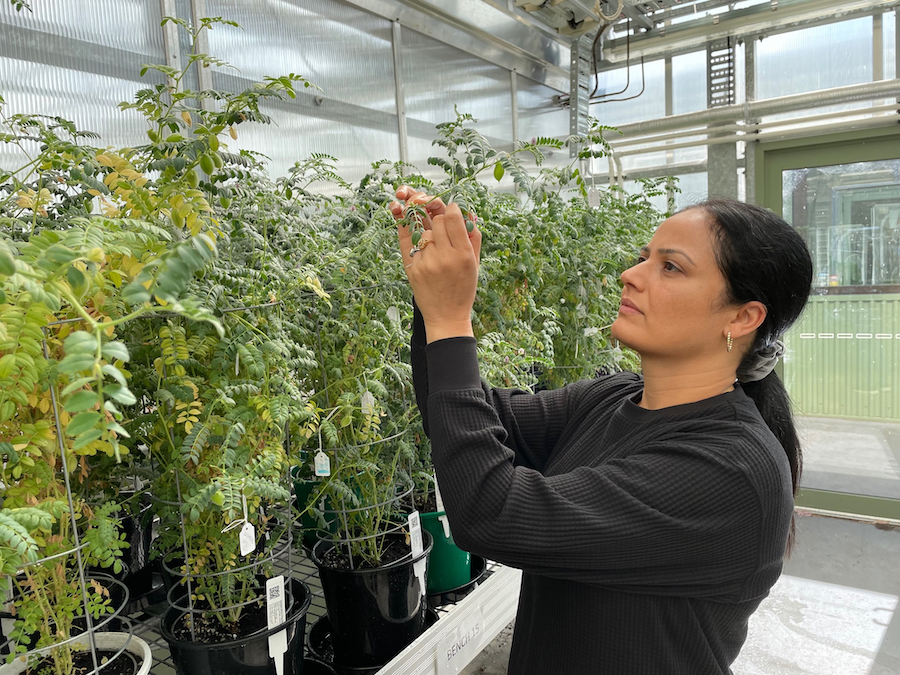A multi-pronged push targeting Ascochyta blight (AB) in chickpeas has been launched that aims to achieve a major step change in the control of the costly disease.
The new initiative has identified five key areas that each need to make progress in order to deliver disease control breakthroughs. Each area has received investment from GRDC, with the five resulting research programs operating in an integrated and outcome-focused manner.
The overall initiative is called ‘Towards effective genetic and sustainable management of Ascochyta blight of chickpeas’ and is managed at GRDC by Dr Francis Ogbonnaya.
“The five programs act in concert so that together they can achieve outcomes that are greater than the sum of the parts,” Dr Ogbonnaya says. “Each program taps into the most relevant skills – wherever they occur in Australia or internationally – to address key limitations in AB disease control.”
Phenotyping

Ascochyta blight impact on chickpea variety, Kyabra. Photo: AgVic
One of biggest limitations the initiative wants to overcome centres on phenotyping – the ability to reliably challenge large chickpea populations with relevant AB isolates and accurately score for resistance under realistic paddock conditions.
 Dr Joshua Fanning at the Horsham SmartFarm in Victoria. Photo: AgVic
Dr Joshua Fanning at the Horsham SmartFarm in Victoria. Photo: AgVic
This is the goal of Program 4, which is underway at the Horsham SmartFarm in Victoria and led by Dr Grant Hollaway and Dr Joshua Fanning of Agriculture Victoria (AgVic).
“A major limitation to the development of resistant varieties is the screening capacity available to plant breeders,” Dr Hollaway says. “Therefore, the AgVic team has developed large-scale, field-based screening to cater for 20,000 single rows per annum.”
 Genomic selection combined with speed breeding is improving chickpea resistance to Ascochyta blight at the Horsham SmartFarm. Photo: AgVic
Genomic selection combined with speed breeding is improving chickpea resistance to Ascochyta blight at the Horsham SmartFarm. Photo: AgVic
Dr Fanning explains that the key to accelerating the development of resistant varieties by breeders is uniform disease pressure across a field nursery site every year, regardless of seasonal conditions.
To support uniform and reliable screening, a new lateral irrigator has been installed in the field, which supports conducive conditions for disease development regardless of the season.
“The new field site will deliver reliable resistance scores at a scale necessary to screen chickpea lines from breeders, pre-breeders and the National Variety Trial ratings,” Dr Fanning says. “Importantly, the site will also screen chickpea germplasm produced by other programs within the AB initiative.”
With Victoria home to Australia’s more-aggressive AB isolates, the site is also ideally located to challenge chickpeas with the most-relevant mix of stubble-derived isolates. A new state-of-the-art glasshouse facility, which opened during 2022 at the Horsham SmartFarm, is also available to screen chickpea material against specific isolates.
Resistance genetics
At the South Australian Research and Development Institute (SARDI) and AgVic, the focus is on the genetics of AB resistance. Led by Dr Tim Sutton (SARDI) in collaboration with Dr Sukhjiwan Kaur (AgVic), Program 3 aims to apply the most powerful pre-breeding tool available – genomic selection combined with speed breeding – to generate germplasm with improved resistance.
Genomic selection involves matching resistance traits (quantified using phenotyping data) against the genetic diversity present in chickpeas (mapped using genome-wide DNA markers).
Computationally intense methods are used to rank the various sources of resistance and to assign breeding values (called genomic estimated breeding values, or GEBVs). These values are used to drive a pre-breeding program that is optimised to integrate resistance sources using the accelerated (or ‘speed breeding’) pipeline developed by AgVic. This pipeline can turn over one chickpea generation every 13 weeks.

Dr Sukhjiwan Kaur of AgVic tending to chickpea material bred to have improved levels of resistance to Ascochyta blight. Photo: Ag Vic
Dr Kaur explains: “We estimate that the severity of AB infection in chickpeas can be reduced by about 31 per cent per breeding cycle using genomic selection.”
Genomic selection works best with very large datasets of both genomic and phenotypic diversity. To boost the data available, the researchers collected and pooled data from past AB resistance studies from across Australia and created a new ‘metadata’ resource.
A new collection of chickpea germplasm is also undergoing fresh analysis (both genotyping with DNA markers and phenotyping). This will generate new data to combine with the old, while also boosting the genetic diversity available in the combined dataset.
Included is germplasm from the Australian Grains Genebank, the Vavilov collection, material from international research centres (particularly the International Crops Research Institute for the Semi-Arid Tropics, ICRISAT, and the International Center for Agriculture Research in the Dry Areas, ICARDA). It also includes wild chickpea relatives for an extra boost of genetic diversity and lines from previous Australian breeding and pre-breeding programs.
Phenotyping of this new material will take place at the SARDI Terrace facility and at the Program 4 site in Horsham. Genotyping will make use of a Multi-species Pulse DNA chip developed in a previous GRDC investment.
The strategy used in this program is especially powerful since AB resistance in chickpea generally derives from many genes that are dispersed throughout the genome that each having a minor effect. They are notoriously difficult to exploit using standard breeding techniques.
“Since the breeding values have the potential to capture the input of all the minor resistance genes, breeding based on these values implicitly carries over the best-ranked net sources of resistance,” Dr Sutton says. “It also carries over multiple, stacked sources of resistance, making it harder (and potentially slower) for the pathogen to overcome. That means the GEBVs are likely to produce a more durable form of resistance irrespective of what genes are at play.”
Dr Kaur adds that simulation modelling is also being used to identify the best breeding strategies to bring together the optimal resistance gene combinations.
Program 3 will result in the handover of advanced germplasm generated through the speed-breeding pipeline – along with GEBVs – to chickpea breeders, who will introduce the new and more-durable forms of AB resistance into commercial varieties.
Dr Sutton reports that Chickpea Breeding Australia is set to implement GEBV-driven breeding capability allowing for a smooth transition of the best-ranked germplasm.
Transfer of advanced lines and GEBVs to breeders is scheduled to start in 2024.

The speed breeding facility developed by AgVic that can turn over one chickpea generation every 13 weeks. Photo: AgVic
Typing the pathogen
Limitations arising from an inability to properly type AB pathogens is being addressed in Program 2, led by Dr Aladdin Hamwieh at ICARDA. The international centre is working closely with collaborators in Australia, including Dr Kurt Lindbeck at the NSW Department of Primary Industries (DPI) at Wagga Wagga and Dr Lars Kamphuis at Curtin University.
The aim is to standardise how pathogens are typed, especially with regards to aggressiveness. This involves developing an international differential set of chickpea genotypes and isolates that allow the aggressiveness of new AB pathogen samples to be typed and understood against known disease resistance genes.
“Unlike cereal pathogens, knowledge of the chickpea-AB system suffers from a lack of knowledge on key drivers of population changes, such as sexual reproduction, directional selection and gene flow,” Dr Hamwieh says. “We are working to develop differential sets that can be used to monitor pathogen virulence or aggressiveness changes at national, regional and international levels.”
With regards to the pathogen, isolates from India, Ethiopia, Tunisia, Morocco, Lebanon, Turkey, Canada, Spain and Australia have been collected from growers’ fields and research centres. A collection of 126 isolates has been propagated and the genomes entirely sequenced, with work underway to map virulence (or effector) genes.
The mapping work is a focus at the Centre for Crop and Disease Management (CCDM) at Curtin University. To get at the virulence genes, Dr Kamphuis is developing a specialised AB population that has contrasting responses against the differential chickpea lines.
“This approach was first used in the related Ascochyta blight pathogen of lentils and led to the discovery of the first avirulence gene for this species,” says Dr Kamphuis. “This A. lentis avirulence gene can differentiate two pathotypes of the species and the identification of such genes in chickpea AB can subsequently be incorporated in cost-effecting DNA-based risk assessment tools to be developed in partnership with Program 1.”
Both desi and kabuli types were included in a total set of 200 chickpea lines used to standardise analysis of resistance. Included were 25 AB-resistant lines that performed well in Australia, as well as 86 varieties sourced from 25 countries and 44 elite lines from ICARDA’s breeding program.
This seed-set has been evaluated under natural disease pressure in AB hotspots located in Turkey, Lebanon, Tunisia, Ethiopia, Morocco and India. Results from 2021 found that eight genotypes were resistant, 127 had moderate resistance levels and the rest ranged from moderately susceptible to susceptible.
Six genotypes whose resistance were stable at different sites – and therefore across pathogen populations – were detected. These are being crossed to create a population to identify the underlying resistance genes.
“All up, 126 international AB isolates and 200 chickpea lines (called the GABRSC set) were collected and used to develop a platform to understand the relationship between pathogen populations and chickpea resistance,” Dr Hamwieh says.
All this material is being shared with the Australian partners for evaluation in Programs 1, 3 and 4.
Pathogen dynamics
The threat posed by AB is not a constant one since the pathogen can adapt and evolve. The dynamic nature of the threat to the chickpea industry is also taken into account within the integrated AB initiative through Program 1, which is led by Dr Rebecca Ford and Dr Ido Bar at Griffith University.
Their focus is on aggressiveness, the characteristic of an isolate that determines disease severity. They are also looking at how aggressiveness evolves in the field, including whether it provides a fitness advantage.
Field studies with a cocktail of isolates are exploring these issues over three years. PhD candidate Haley Wilson is undertaking this work with the NSW DPI in Tamworth.
The genetics that underlie pathogen population changes are also under investigation, with a pool of 200 isolates scheduled to have their entire genome sequenced. This amounts to a ‘pan-genome’ analysis that can provide higher-order insights about the genetic changes that cause shifts in epidemiology.
“Australian isolates are very clonal, with little evidence for sexual reproduction,” Dr Ford says. “Despite this underlying genetic similarity, we see significant diversity for aggressiveness, which means there are genes that are adapting within Australian paddocks. This is where a pan-genome analysis can help detect the genes that are diverging, where they came from and how they are evolving to affect aggressiveness.”
Importantly, this work will also develop predictive diagnostic capabilities. This will involve comparing genome sequence data to categorise isolates into clusters that differ in their aggressiveness. Any new isolate can then be typed relative to these clusters, which should provide an estimate of the risk posed to growers by the new pathogen.
“Cheap, rapid, DNA-based risk assessment tools are something that agronomists are keen on and early indications are encouraging that they can be developed,” Dr Bar says.
This program will feed information and isolates to the field nursery in Horsham and work closely with the agronomy work underway in Program 5.
Paddock control measures
Integrated disease management (IDM) in the paddock is the focus of Program 5, led by Dr Susie Sprague and Dr Luke Barrett at CSIRO.
This program is looking to add to in-season control options by understanding what happens once the crop is harvested that allows the pathogen to persist in between seasons. The program has several research arms.
There is work on understanding the extent to which the fungus can grow and persist on dead stubble. Dr Barrett explains that on crops, AB behaves like a necrotrophic fungus, invading living tissue, killing it and then eating the dead material. Once the plant senesces and is reduced to stubble, AB behaves like a saprophytic fungus, which branches into the dead cellulose and releases digestive enzymes. To better understand this shift and how to antagonise it, the CSIRO team is growing AB on stubble to quantify growth characteristics and spore production.
At the same time, stubble is being collected from trial sites that hosted chickpea lines with variable levels of genetic resistance and different fungicide regimes. The aim is to assess impacts on out-of-season AB persistence and growth following exposure to fungicides and different resistance genes.
To do this analysis, a new polymerase chain reaction (PCR) test has been developed to detect and quantify AB fungi. Called a digital PCR test, the new diagnostic tool has been validated and found to work well. It now permits many more stubble samples to be analysed far more quickly. Already, about 2000 samples from trials by NSW DPI in Tamworth in 2020 have been analysed and testing continues.
“So far, we are finding that in-season fungicide use helps to reduce the amount of inoculum that carries over between seasons,” Dr Barrett says. “Choice of varieties also matters, but the most-susceptible varieties do not necessarily carry over the most spores.”
Importantly, the team found that AB can colonise weedy, non-chickpea plants as well as canola. These alternative hosts potentially provide a green bridge for AB and work is underway to better understand these processes. This includes the analysis of canola crops sown into chickpea stubble.
Program 5 is also investigating opportunities to add to the toolkit available to manage AB in the paddock. This work is primarily looking at microorganisms as biocontrol agents to inhibit AB growth or out-compete it on stubble. The results obtained look promising, including through the use of Streptomyces strains.
“Ultimately, all the new understanding will get incorporated into a computer model that can be used on-farm to optimise choice of varieties, fungicide regimes, rotations to maximise integrated disease control strategies at the farm’s landscape level,” Dr Barrett says.
He adds that interactions with other programs are vital and he notes that his program:
- exchanges isolates routinely with Dr Ford’s team of fungal epidemiologists in Program 1;
- maintains a dialogue with genetic researchers in Program 3 regarding the impact of resistance genes on the carry-over of fungus on stubble; and
- works with the Program 4 disease nursery in Horsham, especially in the search for alternative AB hosts and in understanding the decay rate of AB in chickpea stubble.
“Interactions with other programs are crucial in this work and are helping better understand quantity and duration of inoculum production, infection efficiency and host-pathogen interactions,” he says. “This level of integration is happening across the initiative and it is creating exciting new opportunities to make real progress in the control of AB.”
More information: Ido Bar, i.bar@griffith.edu.au; Rebecca Ford, rebecca.ford@griffith.edu.au; Aladdin Hamwieh, a.hamwieh@cgiar.org; Lars Kamphuis, lars.kamphuis@curtin.edu.au; Tim Sutton, tim.sutton@sa.gov.au; Sukhjiwan Kaur, sukhjiwan.kaur@agriculture.vic.gov.au; Grant Hollaway, grant.hollaway@agriculture.vic.gov.au; Joshua Fanning, joshua.fanning@agriculture.vic.gov.au; Susie Sprague, susie.sprague@csiro.au; Luke Barrett, luke.barrett@csiro.au

























































